Well, I don't know if switching modelling software will make a difference. I had already posted in my first post a 25-litre box alignment. Am repeating here: 25-litre graph
I cannot interpret how to read the green line and the orange line. Why are there those peaks in the waves?
In any case, I can't do DSP for this project, I am aiming to build a simple passive speaker.
I cannot interpret how to read the green line and the orange line. Why are there those peaks in the waves?
In any case, I can't do DSP for this project, I am aiming to build a simple passive speaker.
Hence Real world speaker design.
and why I dont mean any secret meaning to.
A speaker is, what a speaker is.
And why simulation can lead to over analyzing
or endless fiddling to magically get " more bass"
A speaker suspension is only so stiff, or so loose.
The box is obviously blocking the rear wave so it does not
cancel the forward wave.
But a " good box" helps control or dampen that movement.
To improve or have more control.
not too much, not too little.
Bigger box usually makes " more bass"
but eventually becomes too big. No control.
or reach " Xmax" quicker
Smaller box will improve control or give you more
power handling. Or not reach xmax so quickly.
Tradeoff " less bass"
" free air" resonance is 30 Hz in this case.
Once a driver goes in a box, resonance will rise.
Smaller the box , more it rises. Basically the big impedance peak.
Which is all you ever need to care to know. The real end of the road
of what that speaker does, electrically and accurately.
Sealed box the single impedance peak frequency, end of road.
Ported box, first impedance peak caused by same thing=
Box size....still the end of the road.
Reflex or vented will " measure" more bass
or sound like more bass. It Just ....Hums along at a one set frequency.
No electrical movement or accuracy. Just air resonating at one set frequency.
More pressure at given frequency, hence Higher measurements.
No accuracy, no electrical reproduction just...hummmm
Modeling software just gives you a fairly realistic " window"
of how big or small a box can be. Based on how loose or tight the suspension
is. You can make that "window" as big or small as what " research" has found
acceptable. Hence Q of .5= Larger or around .9 smaller.
.7 being a average tradeoff in the middle.
Hence the common " butterworth" alignment usually working well.
real reason mainly for modeling to see how realistic that is.
and what the driver can really do electrically/ mechanically.
Otherwise within reason there is no magic reflex tuning.
It does not need to be much higher or lower than " free air"
resonance. Since that is the absolute lowest the impedance peak will go.
With absolutely no control. no box. But we need a box and the impedance
peak will always rise no matter what. And that impedance peak is the end
of realistic accurate frequency response.
Hence a speaker is, what the speaker is.
Resonance is set, that is all it does.
The suspension is only so loose or so tight.
that is all it does.
Every speaker will be have slightly bigger or smaller
needed volume depending on the suspension.
The model will show you how big the volume will
need to be at .5 or .9 or the window of how large/small
you can make it. To what is considered favorable or
reasonable good performance.
Make the box big enough for .5
tune 3 to 5 Hz above or below resonance.
That is all it does.
Make the box small enough for .9
tune 3 to 5 Hz above or below resonance
That is all it does.
Hence most shoot in the middle .7
or plain old butterworth.
that is all it does.
if happy...build
unhappy...find another driver
and why I dont mean any secret meaning to.
A speaker is, what a speaker is.
And why simulation can lead to over analyzing
or endless fiddling to magically get " more bass"
A speaker suspension is only so stiff, or so loose.
The box is obviously blocking the rear wave so it does not
cancel the forward wave.
But a " good box" helps control or dampen that movement.
To improve or have more control.
not too much, not too little.
Bigger box usually makes " more bass"
but eventually becomes too big. No control.
or reach " Xmax" quicker
Smaller box will improve control or give you more
power handling. Or not reach xmax so quickly.
Tradeoff " less bass"
" free air" resonance is 30 Hz in this case.
Once a driver goes in a box, resonance will rise.
Smaller the box , more it rises. Basically the big impedance peak.
Which is all you ever need to care to know. The real end of the road
of what that speaker does, electrically and accurately.
Sealed box the single impedance peak frequency, end of road.
Ported box, first impedance peak caused by same thing=
Box size....still the end of the road.
Reflex or vented will " measure" more bass
or sound like more bass. It Just ....Hums along at a one set frequency.
No electrical movement or accuracy. Just air resonating at one set frequency.
More pressure at given frequency, hence Higher measurements.
No accuracy, no electrical reproduction just...hummmm
Modeling software just gives you a fairly realistic " window"
of how big or small a box can be. Based on how loose or tight the suspension
is. You can make that "window" as big or small as what " research" has found
acceptable. Hence Q of .5= Larger or around .9 smaller.
.7 being a average tradeoff in the middle.
Hence the common " butterworth" alignment usually working well.
real reason mainly for modeling to see how realistic that is.
and what the driver can really do electrically/ mechanically.
Otherwise within reason there is no magic reflex tuning.
It does not need to be much higher or lower than " free air"
resonance. Since that is the absolute lowest the impedance peak will go.
With absolutely no control. no box. But we need a box and the impedance
peak will always rise no matter what. And that impedance peak is the end
of realistic accurate frequency response.
Hence a speaker is, what the speaker is.
Resonance is set, that is all it does.
The suspension is only so loose or so tight.
that is all it does.
Every speaker will be have slightly bigger or smaller
needed volume depending on the suspension.
The model will show you how big the volume will
need to be at .5 or .9 or the window of how large/small
you can make it. To what is considered favorable or
reasonable good performance.
Make the box big enough for .5
tune 3 to 5 Hz above or below resonance.
That is all it does.
Make the box small enough for .9
tune 3 to 5 Hz above or below resonance
That is all it does.
Hence most shoot in the middle .7
or plain old butterworth.
that is all it does.
if happy...build
unhappy...find another driver
Last edited:
Unibox produces the SPL at a given input power (voltage I think). Basta! gives the max acoustic SPL at given Xmax. From the tech doc on the site:Well, I don't know if switching modelling software will make a difference. I had already posted in my first post a 25-litre box alignment. Am repeating here: 25-litre graph
I cannot interpret how to read the green line and the orange line. Why are there those peaks in the waves?
In any case, I can't do DSP for this project, I am aiming to build a simple passive speaker.
Basta! allows for calculation of the maximum output level of the system. It is calculated based on these limits:
Maximum peak cone excursion
Maximum electric RMS power in RE
Maximum RMS voltage from the power amplifier
Maximum RMS velocity in the vent(s)
Maximum RMS excursion of the vent(s)
The maximum output level is the highest level at which none of these limits are exceeded.
So the peaks are calculated from several design objectives. Now that is quite clever. BTW, if one takes the trouble reading the technical documentation, the conclusion soon could be that Basta! is pretty well thought out in general. I like it better than Unibox or WinISD.
And on DSP or not, really, the Keele B6 arrangement only needs one opamp, some capacitors and resistors between the pre and power amp. Something like a poor man's KEF Kube. But it works really well protecting your poor speakers. Common sense does, too.
Last edited:
Ok, in that case, what Basta gives me seems to be a lot more sophisticated than just the excursion limit, but my requirement, as explained in my first post, is to worry about only the one factor -- the excursion limit. I am only worrying about what tuning will be safe enough to not damage my driver when used in a domestic environment. For this objective, I don't need to worry about max excusion (?) of vent, max RMS velocity of vent, max RMS voltage of the amp, max electric RMS power in RE (what is RE?) and so on. I just want to see how much further than the excursion-limit graph I can allow the "unlimited" SPL to reach.
The Keele B6 arrangement --- I'll keep it aside in this discussion. I found Keele's paper of June 1975: http://xlrtechs.com/dbkeele.com/PDF/Keele (1975-07 AES Published) - New Set of VB Alignments.pdf
The Keele B6 arrangement --- I'll keep it aside in this discussion. I found Keele's paper of June 1975: http://xlrtechs.com/dbkeele.com/PDF/Keele (1975-07 AES Published) - New Set of VB Alignments.pdf
Last edited:
Morning coffee think through: xmax is usually 10% distortion isn't it? Drivers can go further than this but of course the sound will be a lot worse, hopefully bad enough so that the operator can reach the volume knob before its too late. Hitting mechanical maximum excursion kills the driver eventually so you want to avoid that. How much more is the mechanical maximum then? Specsheet doesn't list it but it says 5.5mm xmax and voice coil length of 16mm so is it perhaps 2-3mm more travel and mechanical limits reached? Perhaps the surround maxes out before?
The program probably is right, certain excursion given the cone area is need for particular SPL and the red line is something you need to obey in reality, not much output available beyond xmax. Your biggest worry is excursion below the tuning, its wild and provides basically no audible output. Based on these I would try to answer the question by changing the simulation a bit: change the max excursion to the 8mm imagined mechanical excursion limit, then add high pass filter to the simulation and keep the driver excursion below the red line down to around 30Hz or so with assumption not much music content below 30Hz so we can perhaps get over the line a bit there.
But really, it all depends on how much power you feed in, you can kill the driver in any box alignment. Use highpass filter and/or make it closed box to limit excursion. Make biggest box possible for least power required to destroy the driver. Or, use smallest box possible and feed it huge power. Basically the red line (xcursion max) is the limit of maximum output you get from the box no matter what the alignment. Remember the box size affects your midrange as well 🙂
The program probably is right, certain excursion given the cone area is need for particular SPL and the red line is something you need to obey in reality, not much output available beyond xmax. Your biggest worry is excursion below the tuning, its wild and provides basically no audible output. Based on these I would try to answer the question by changing the simulation a bit: change the max excursion to the 8mm imagined mechanical excursion limit, then add high pass filter to the simulation and keep the driver excursion below the red line down to around 30Hz or so with assumption not much music content below 30Hz so we can perhaps get over the line a bit there.
But really, it all depends on how much power you feed in, you can kill the driver in any box alignment. Use highpass filter and/or make it closed box to limit excursion. Make biggest box possible for least power required to destroy the driver. Or, use smallest box possible and feed it huge power. Basically the red line (xcursion max) is the limit of maximum output you get from the box no matter what the alignment. Remember the box size affects your midrange as well 🙂
Last edited:
The increase of excursion above the limit is already done by adding a factor of 1.15 to the excursion. So I'm already reading the graphs with 15% additional excursion. About a high-pass filter -- I'll see how it can be added. Not clear about that currently.
Have you tried VituixCAD enclosure tool? There is max SPL graph that tunes in real time as you scroll the box / tuning / filter parameters with mouse, very nice to experiment with it. The max SPL which is limited by excursion or thermal (max W I think), limits of the driver not the box alignment.
Tried some driver, not the same as yours as it doesn't seem to be on the database. Basically, the box size/alignment can move the maxima in max SPL graph that occurs at the box tuning, but it doesn't help because your music contains also other frequencies than the tuning frequency so the whole output needs to fit below the max spl curve.

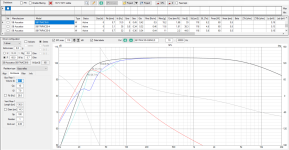
Basically, the gray line needs to be under the light blue trace at all frequencies in order not to destroy the driver, keep excursion at bay. In this case max power 15W and high pass filter around 30Hz.
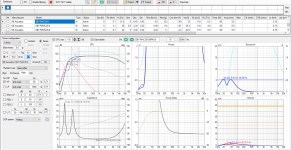
Changing the box volume moves the total SPL trace some, but no matter what it is the output is limited by the driver volume displacement. If you make lower tuning, max SPL reduces for the whole bandwidth, if you make higher tuning, max SPL raises. Classic trade-off between size output and bandwidth.
Basically one watches the light blue line in SPL graph while changing box parameters. Then adjust the power and high pass filter to keep the gray line below.
If you would like 90db at 30Hz, then make the blue line there and see what kind of a box it is. Gray line doesn't get to the same mark while staying under? Then adjust until it does, or swap for another driver. This is max performance of the box, 90db with 10% distortion with 15W amp, so 75db listening level with some headroom for peaks with 10% distortion, which basically distorts the whole bandwidth of the driver so you'd probably want to limit the low end so that bit more capability remains, tune higher. You might be able to move the speaker / listening position in room so that there is 10db peak at the 30Hz.
Its tough to demonstrate it here but try it, quite simple and fast to find suitable configurations, takes about two minutes to scope. Perhaps its as easy with Basta!?
Tried some driver, not the same as yours as it doesn't seem to be on the database. Basically, the box size/alignment can move the maxima in max SPL graph that occurs at the box tuning, but it doesn't help because your music contains also other frequencies than the tuning frequency so the whole output needs to fit below the max spl curve.


Basically, the gray line needs to be under the light blue trace at all frequencies in order not to destroy the driver, keep excursion at bay. In this case max power 15W and high pass filter around 30Hz.

Changing the box volume moves the total SPL trace some, but no matter what it is the output is limited by the driver volume displacement. If you make lower tuning, max SPL reduces for the whole bandwidth, if you make higher tuning, max SPL raises. Classic trade-off between size output and bandwidth.
Basically one watches the light blue line in SPL graph while changing box parameters. Then adjust the power and high pass filter to keep the gray line below.
If you would like 90db at 30Hz, then make the blue line there and see what kind of a box it is. Gray line doesn't get to the same mark while staying under? Then adjust until it does, or swap for another driver. This is max performance of the box, 90db with 10% distortion with 15W amp, so 75db listening level with some headroom for peaks with 10% distortion, which basically distorts the whole bandwidth of the driver so you'd probably want to limit the low end so that bit more capability remains, tune higher. You might be able to move the speaker / listening position in room so that there is 10db peak at the 30Hz.
Its tough to demonstrate it here but try it, quite simple and fast to find suitable configurations, takes about two minutes to scope. Perhaps its as easy with Basta!?
Last edited:
Never played with the VCAD enclosure tool before so pardon 😀
Another driver with 38Hz Fs by manufacturer. With given box size and adjusting just the box tuning, trying to get max output at 30Hz while still keeping the gray line below the light blue: there is slight advantage when the tuning is at the target frequency. Difference being ~2db.
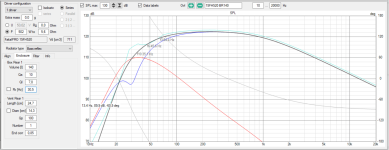
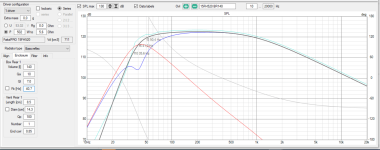
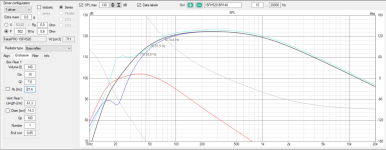
If allowed to change all the parameters like box size, then I can get even little bit more at this particular frequency. Fs is quite close, and can't get much more in this case no matter what I do, the driver excursion limits the performance.
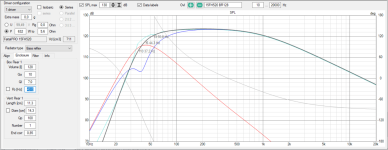
The simulator is fun as its fast to tune with mouse wheel and no matter what I do the light blue line showing max SPL doesn't change much. The tuning frequency moves the kink but I really can't utilize that because the excursion is limited above and below the kink, the tuning frequency.
Ok, whats the difference then? To me it looks like when the box is auto aligned, tuned around the box resonance, the max output capability at low bass is achieved. Difference is the shape of the knee, the alignment, and how it would work in a room and how much amplifier power is required and of course physical size of the box. The differences in output on the bass seem small, within 2db, while room modes would make a huge difference. Also there would be a lot of difference how much the box costs if volume doubles, what amplifier you have, how difficult it is to build, does the port fot inside the box and so on. These matters seem at least as important as the 2db difference in max SPL capability.
edit. although this is unrelated driver and box to the thread, comparing this 15" driver in ~130litre enclosure with 500W of power can reach ~105db around 30Hz with 10% distortion. That is about 90db listening level with 15db peaks with 10% distortion. Or if listening level was 75db like with the small SB woofer there would be less distortion on the peaks, more dynamic headroom. Although this is much more serious system size and power wise the difference is only that much, barely capable for industry standard 85db listening level. Also illustrates how you cannot gain too much performance just by adjusting tuning, you need to increase size of the system. Quadruple volume displacement for every octave OR double max SPL at same frequency. Well, of course there would be two to a stereo system, room boosting it and so on 🙂
sorry for the sideline, was interesting and thought to post it.
Another driver with 38Hz Fs by manufacturer. With given box size and adjusting just the box tuning, trying to get max output at 30Hz while still keeping the gray line below the light blue: there is slight advantage when the tuning is at the target frequency. Difference being ~2db.



If allowed to change all the parameters like box size, then I can get even little bit more at this particular frequency. Fs is quite close, and can't get much more in this case no matter what I do, the driver excursion limits the performance.

The simulator is fun as its fast to tune with mouse wheel and no matter what I do the light blue line showing max SPL doesn't change much. The tuning frequency moves the kink but I really can't utilize that because the excursion is limited above and below the kink, the tuning frequency.
Ok, whats the difference then? To me it looks like when the box is auto aligned, tuned around the box resonance, the max output capability at low bass is achieved. Difference is the shape of the knee, the alignment, and how it would work in a room and how much amplifier power is required and of course physical size of the box. The differences in output on the bass seem small, within 2db, while room modes would make a huge difference. Also there would be a lot of difference how much the box costs if volume doubles, what amplifier you have, how difficult it is to build, does the port fot inside the box and so on. These matters seem at least as important as the 2db difference in max SPL capability.
edit. although this is unrelated driver and box to the thread, comparing this 15" driver in ~130litre enclosure with 500W of power can reach ~105db around 30Hz with 10% distortion. That is about 90db listening level with 15db peaks with 10% distortion. Or if listening level was 75db like with the small SB woofer there would be less distortion on the peaks, more dynamic headroom. Although this is much more serious system size and power wise the difference is only that much, barely capable for industry standard 85db listening level. Also illustrates how you cannot gain too much performance just by adjusting tuning, you need to increase size of the system. Quadruple volume displacement for every octave OR double max SPL at same frequency. Well, of course there would be two to a stereo system, room boosting it and so on 🙂
sorry for the sideline, was interesting and thought to post it.
Last edited:
One more quick, like in the first post, ~105db output at 40Hz cannot happen with that driver. Seas Lroy26 was smallest driver I quickly found that could do it. Takes about 14mm of excursion from the 10" driver to reach it, about 35l box with ~200W power.
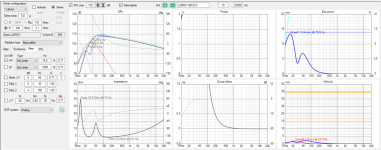
So, in grand scheme of things the tuning is moot as long as its about around fs for a given driver. If the box and driver were big and you had only small amplifier, perhaps then you could go with low tuning, get very low extension but no high SPL capability of course, as trade-off. Still, it seems high pass filter would be necessary in order not to over excursion.
Lroy in 300litre box, 10Hz tuning and 5Hz high pass filter, 20W amplifier power.
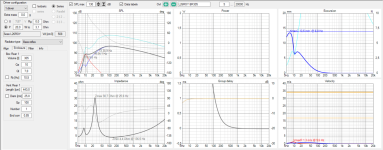
Output for both are about the same around the 10Hz, difference is the other needs 10x more power and the is10x box volume. Same driver, same physical limits, its just circling around the same response.

So, in grand scheme of things the tuning is moot as long as its about around fs for a given driver. If the box and driver were big and you had only small amplifier, perhaps then you could go with low tuning, get very low extension but no high SPL capability of course, as trade-off. Still, it seems high pass filter would be necessary in order not to over excursion.
Lroy in 300litre box, 10Hz tuning and 5Hz high pass filter, 20W amplifier power.

Output for both are about the same around the 10Hz, difference is the other needs 10x more power and the is10x box volume. Same driver, same physical limits, its just circling around the same response.
The Seas L26ROY seems to be the driver (or very similar to the driver) Linkwitz used for his LX.521 OB -- he needed huuge excursion, so we have 56mm excursion peak-to-peak before damage.
I'm still figuring out the VituixCAD box design section. But looking at one of your graphs two posts back:

Are you really modelling with a vent 1.3 metres long and six inches in diameter?😳
I'm still figuring out the VituixCAD box design section. But looking at one of your graphs two posts back:
Are you really modelling with a vent 1.3 metres long and six inches in diameter?😳
Last edited:
No just scrolling around whats possible on the graphs, scrolling the box size and Fb never checking out what the port is 🙂 if you do it like this you get the maximal range of options that the driver can do, sweeping around, which is then further limited by practical stuff like port length, port noise and so on 🙂 I did it so because all I wanted to see was how much difference there is with box size and tuning, eg. the alignment, and how it relates to power and highpass filter.
to experiment yourself:
Select a driver, click autoalign on the align tab to get into ballpark for the driver, then sweep the box size or Fb, or any other parameter with the mouse wheel . You'll notice its all tied to the driver, box alignment is just cosmetics on top, lessor effect than swapping the driver, or putting the box into a room has.
Of course one can tweak some extreme settings, my point is that the realistic alignments are almost irrelevant the bass response in mind, but makes potentially lot of difference on the mid frequencies, how difficult it is to build and so on, other things than the alignment.
to experiment yourself:
Select a driver, click autoalign on the align tab to get into ballpark for the driver, then sweep the box size or Fb, or any other parameter with the mouse wheel . You'll notice its all tied to the driver, box alignment is just cosmetics on top, lessor effect than swapping the driver, or putting the box into a room has.
Of course one can tweak some extreme settings, my point is that the realistic alignments are almost irrelevant the bass response in mind, but makes potentially lot of difference on the mid frequencies, how difficult it is to build and so on, other things than the alignment.
Last edited:
Hi,
perhaps I don't need to post here anymore as I've quite clearly marked my point already but a nice example just posted on another thread about effects of room. https://www.diyaudio.com/community/threads/building-process-the-loudspeaker-1.379077/post-7301810
Same phenomenon seen in any in-room measurement, like quite resently here https://www.diyaudio.com/community/threads/a-3-way-design-study.376620/post-7288313
Neither of those measurements represents the Q of the box in anyway, at the observation point. ~10db peaks and dips through out the bass reqion is quite typical to see in the measurements, so any alignment can be either lean bass or heavy bass at listening spot just by changing speaker position, or listening position. Same goes for my setup, practical listening position the bass is lean, reaching forward I get nice bass, some places in the room its too heavy.
For this reason I think the box could and should be designed to meet any other targets and relax on the Q seen in simulator graphs, the Q could be sacrificed for something more important. Ok, perhaps avoid high Q peaking response, but any smooth looking slope would be fine.
perhaps I don't need to post here anymore as I've quite clearly marked my point already but a nice example just posted on another thread about effects of room. https://www.diyaudio.com/community/threads/building-process-the-loudspeaker-1.379077/post-7301810
Same phenomenon seen in any in-room measurement, like quite resently here https://www.diyaudio.com/community/threads/a-3-way-design-study.376620/post-7288313
Neither of those measurements represents the Q of the box in anyway, at the observation point. ~10db peaks and dips through out the bass reqion is quite typical to see in the measurements, so any alignment can be either lean bass or heavy bass at listening spot just by changing speaker position, or listening position. Same goes for my setup, practical listening position the bass is lean, reaching forward I get nice bass, some places in the room its too heavy.
For this reason I think the box could and should be designed to meet any other targets and relax on the Q seen in simulator graphs, the Q could be sacrificed for something more important. Ok, perhaps avoid high Q peaking response, but any smooth looking slope would be fine.
Last edited:
Another way to look at it: one should not factor in any boost on the lows with the alignment, like with a reflex box, because if the boost is at room mode null you aren't hearing it anyway, if its on a peak its too loud anyway. In this sense I would always err to the lean bass side as it would likely sound less boomy in room. Perhaps, if there is DSP in the system and one can cut the peaks then it would be fine to align lsight boost, perhaps few db more putput before distortion.
Just use big enough bass system so that there is enough bass capability, headroom. If the bass system is too small, its not possible to fix it with the box alignment especially since the end results are questionable due to room and its usually a compromise taken from something else like midrange performance, for nothing.
Just use big enough bass system so that there is enough bass capability, headroom. If the bass system is too small, its not possible to fix it with the box alignment especially since the end results are questionable due to room and its usually a compromise taken from something else like midrange performance, for nothing.
Last edited:
For the most part, yes
there is far more elaborate methods of manipulating the rear pressure wave.
Eventually it is all just that
manipulating or delaying rear pressure wave.
" magic boxes "
Or just use drivers that can actually mechanical and electrically
reproduce desired bandwidth.
That point, all that is needed is sealed box.
Only theoretical element is correct volume.
there is far more elaborate methods of manipulating the rear pressure wave.
Eventually it is all just that
manipulating or delaying rear pressure wave.
" magic boxes "
Or just use drivers that can actually mechanical and electrically
reproduce desired bandwidth.
That point, all that is needed is sealed box.
Only theoretical element is correct volume.
- Home
- Loudspeakers
- Multi-Way
- Basic question about bass reflex alignment